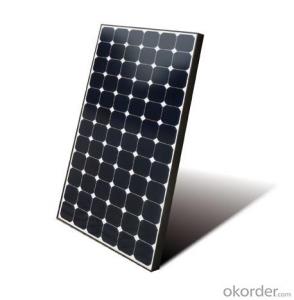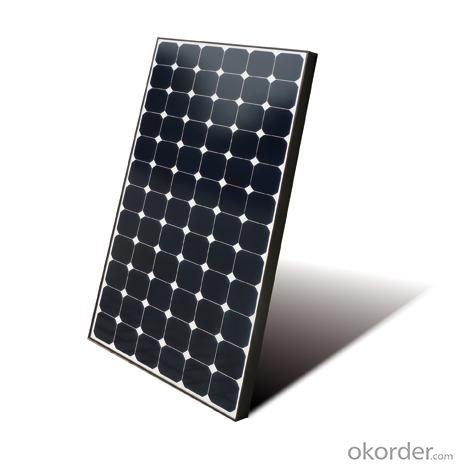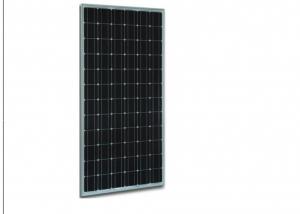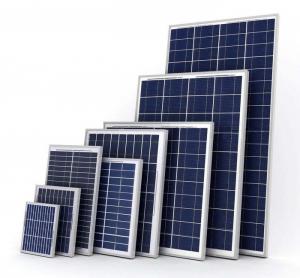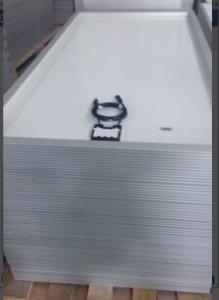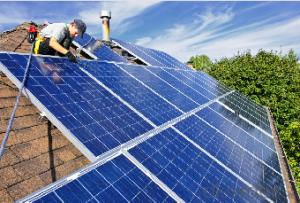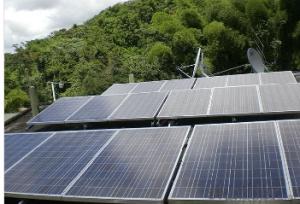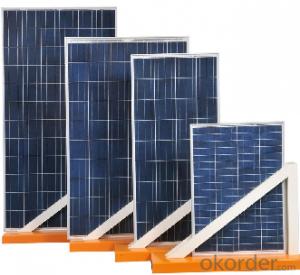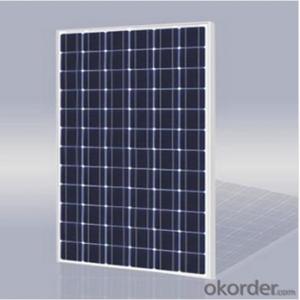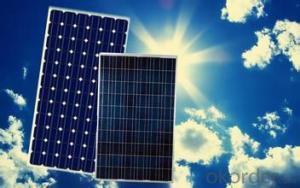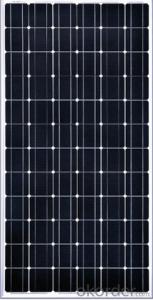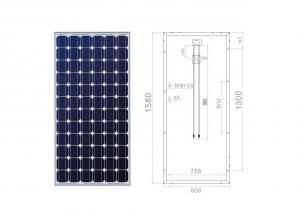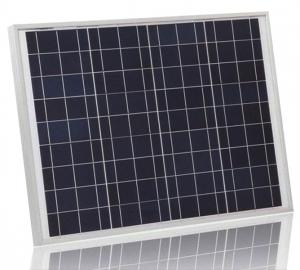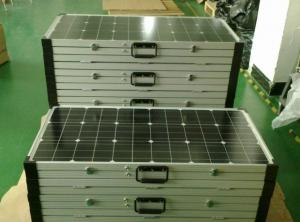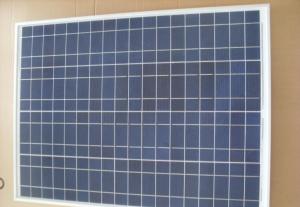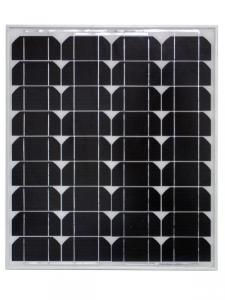Elon Solar Panels 50w CNBM Monocrystalline Silicon Panel for Home Use
- Loading Port:
- Qingdao
- Payment Terms:
- TT OR LC
- Min Order Qty:
- 100 watt
- Supply Capability:
- 1000 watt/month
OKorder Service Pledge
OKorder Financial Service
You Might Also Like
Specification
50W CNBM Monocrystalline Silicon Panel for Home Using
Production description
Most solar modules are currently produced from crystalline silicon (c-Si) solar cells made of multicrystalline andmonocrystalline silicon. In of gallium arsenide (GaAs) and other semiconductor materials. Another emerging PV technology using MJ-cells is concentrator photovoltaics (CPV).
The efficiency of a module determines the area of a module given the same rated output – an 8% efficient 230 watt module will have twice the area of a 16% efficient 230 watt module. There are a few solar panels available that are exceeding 19% efficiency. A single solar module can produce only a limited amount of power; most installations contain multiple modules. A photovoltaic system typically includes a panel or an array of solar modules, a solar inverter, and sometimes a battery and/or solar tracker and interconnection wiring.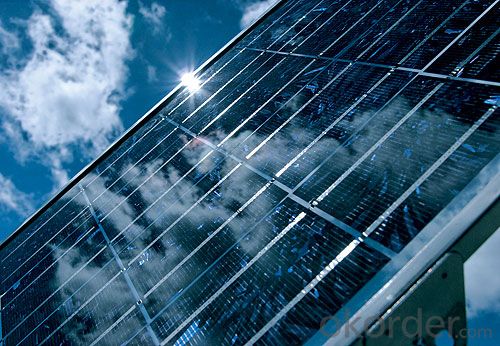
Feature
1.High conversion efficiencies resulting in superior power output performance.
2.Outstanding power output even in low light or high temperature conditions
3.Optimized design for ease of soldering and lamination
4.Long-term stability,reliability and performance
5.Low breakage rate
6.Color uniformaity
Physical characteristic
1. Rigorous quality control meets the highest international standards.
2. High-transmissivity low-iron tempered glass, strong aluminium frame.
3. Using UV-resistant silicon.
4. IS09001/14001/CE/TUV/UL
- Q: Can solar panels be used in areas with high snowfall?
- Yes, solar panels can be used in areas with high snowfall. However, it is important to consider the design and installation of the solar panels to ensure their efficiency and performance in snowy conditions. Snow can reduce the amount of sunlight reaching the panels, which may affect their power generation. Additionally, the panels should be angled properly to allow snow to slide off easily. Regular maintenance, such as clearing snow accumulation, may also be required in snowy regions to optimize the performance of solar panels.
- Q: Why can not the solar panel load directly?
- Solar panels (also known as solar modules) are the core of solar power systems and the most important part of solar power systems.
- Q: Hi there. I live in Colorado, and we obviously get a ton of snow there. I im looking into a solar power system for my home, and I am wondering if the snow will accumulate on the panels, or if, because of the energy passing through, it will melt on contact? By the way we get about 20' of snow each year, and it comes on often. I will also be putting them on my roof. Thanks for your help.
- If you have an electrical backup you could install something to melt the show where the solar panels are installed. You might try installing them near a fireplace chimney if you have one. My thinking tells me if you have a clear raised bubble or pyramid over the panels it might help.
- Q: Can solar panels be installed on desalination plants?
- Yes, solar panels can be installed on desalination plants to generate renewable energy and help power the plant's operations. This integration of solar power can reduce the reliance on fossil fuels and make the desalination process more sustainable.
- Q: Can solar panels be used in areas with high levels of lightning activity?
- Yes, solar panels can be used in areas with high levels of lightning activity. However, they may be more susceptible to damage from lightning strikes compared to other structures. To mitigate this risk, proper grounding and surge protection measures should be implemented to safeguard the solar panels and associated equipment.
- Q: Can solar panels be used for powering a water treatment plant?
- Yes, solar panels can be used to power a water treatment plant. Solar energy can be harnessed and converted into electricity to provide a sustainable and renewable power source for operating the various equipment and processes involved in water treatment. By utilizing solar panels, water treatment plants can reduce their dependence on traditional energy sources and contribute to a more environmentally friendly and cost-effective operation.
- Q: Can solar panels be installed on a pergola or gazebo?
- Yes, solar panels can be installed on a pergola or gazebo. Both structures provide an ideal location for solar panel installation, as they offer unobstructed exposure to sunlight. Additionally, integrating solar panels into a pergola or gazebo can enhance their functionality by providing shade, while generating renewable energy at the same time.
- Q: I want to know that, is there any thing likehow much charge we can get per square feet. in a solar panel.let me know.also, I will appreciate if reference are given.
- Solar okorder
- Q: So you know how the bigger the surface area exposed to the heat radiation means the quicker it'll heat up.Is this what happens with solar panels, they have a large surface area exposing to the sun, so they can get more heat?
- Solar panels do heat up. But that's because the radiant energy from the Sun that lies within the infrared (IR) band of energy causes the material in the panels to heat up. And that's the same for any body that has the Sun shine on it. Your face, for example, will heat up while you get a nice tan on the beach. That's due to the heat producing IR radiant energy. Now if those solar panels are supposed to heat buildings etc., that heat produced in the panels when the IR strikes them will be transferred, usually by some fluid, to floors of the rooms to be heated. And as the amount of heat generated by the Sun is proportional to the area of the solar panels, bigger areas of panel will generate more heat than smaller areas. Photoelectric solar panels are another kind. Here the interest is in the visible band of radiant energy from the Sun. Heat, from IR, is still there, but it is not the product sought by PE solar panels. The visible light photons knock off loosely bound electrons from the photoelectric material (typically silicon based) and those electrons are siphoned off as current. That's where the electrical power comes from for buildings using PE solar panels to provide their own electricity.
- Q: I can't figure out how to charge a Ni Cd (BD 8V Firestorm) battery directly with a solar panel so I've come up with an alternative which might or might not work. I thought I would connect an inverter (I found a nice 400W for $30) to my trucks battery and plug the BD Firestorm battery charger into the inverter. Then I was thinking I could use a 5W solar panel to trickle charge the truck battery and keep it connected after the Ni Cd is charged to ensure the truck battery is topped off. The truck would not be running during this process. Will this solution work? Is there a better solution?
- Two of those solar panels connected in series will easily charge a 8V battery. I would not even be concerned about over voltage the solar cells will have plenty of internal resistance.
Send your message to us
Elon Solar Panels 50w CNBM Monocrystalline Silicon Panel for Home Use
- Loading Port:
- Qingdao
- Payment Terms:
- TT OR LC
- Min Order Qty:
- 100 watt
- Supply Capability:
- 1000 watt/month
OKorder Service Pledge
OKorder Financial Service
Similar products
Hot products
Hot Searches
Related keywords
